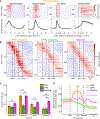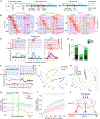Differential encoding in prefrontal cortex projection neuron classes across cognitive tasks
- PMID: 33338423
- PMCID: PMC7935083
- DOI: 10.1016/j.cell.2020.11.046
Differential encoding in prefrontal cortex projection neuron classes across cognitive tasks
Abstract
Single-cell transcriptomics has been widely applied to classify neurons in the mammalian brain, while systems neuroscience has historically analyzed the encoding properties of cortical neurons without considering cell types. Here we examine how specific transcriptomic types of mouse prefrontal cortex (PFC) projection neurons relate to axonal projections and encoding properties across multiple cognitive tasks. We found that most types projected to multiple targets, and most targets received projections from multiple types, except PFC→PAG (periaqueductal gray). By comparing Ca2+ activity of the molecularly homogeneous PFC→PAG type against two heterogeneous classes in several two-alternative choice tasks in freely moving mice, we found that all task-related signals assayed were qualitatively present in all examined classes. However, PAG-projecting neurons most potently encoded choice in cued tasks, whereas contralateral PFC-projecting neurons most potently encoded reward context in an uncued task. Thus, task signals are organized redundantly, but with clear quantitative biases across cells of specific molecular-anatomical characteristics.
Keywords: cell type atlas; cognitive behavior task; mini-endoscopic Ca(2+) imaging; molecular neuroscience; prefrontal cortex; projection mapping; systems neuroscience; transcriptomic neuron type; two-alternative forced choice.
Copyright © 2020 Elsevier Inc. All rights reserved.
Conflict of interest statement
Declaration of interests The authors have no competing interests.
Figures







References
-
- Asaad WF, Rainer G, and Miller EK (1998). Neural activity in the primate prefrontal cortex during associative learning. Neuron 21, 1399–1407. - PubMed
Publication types
MeSH terms
Substances
Grants and funding
LinkOut - more resources
Full Text Sources
Other Literature Sources
Molecular Biology Databases
Miscellaneous

